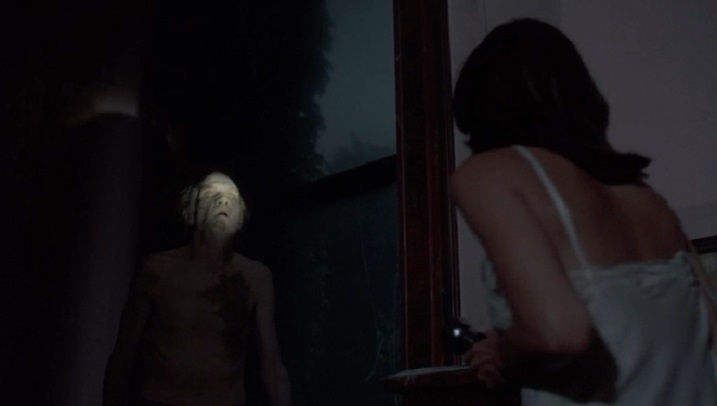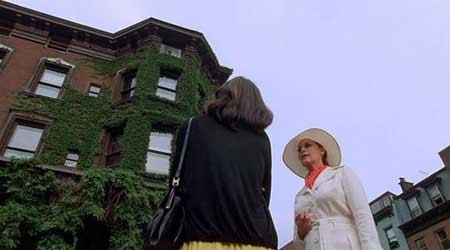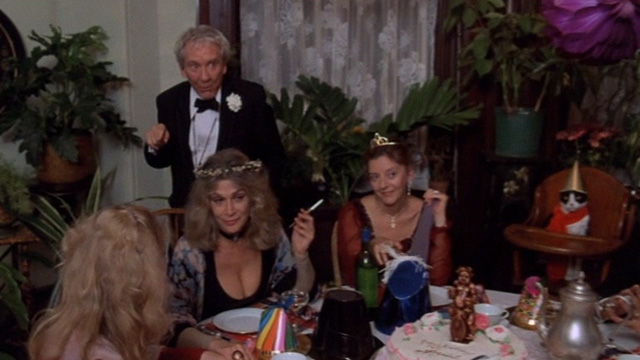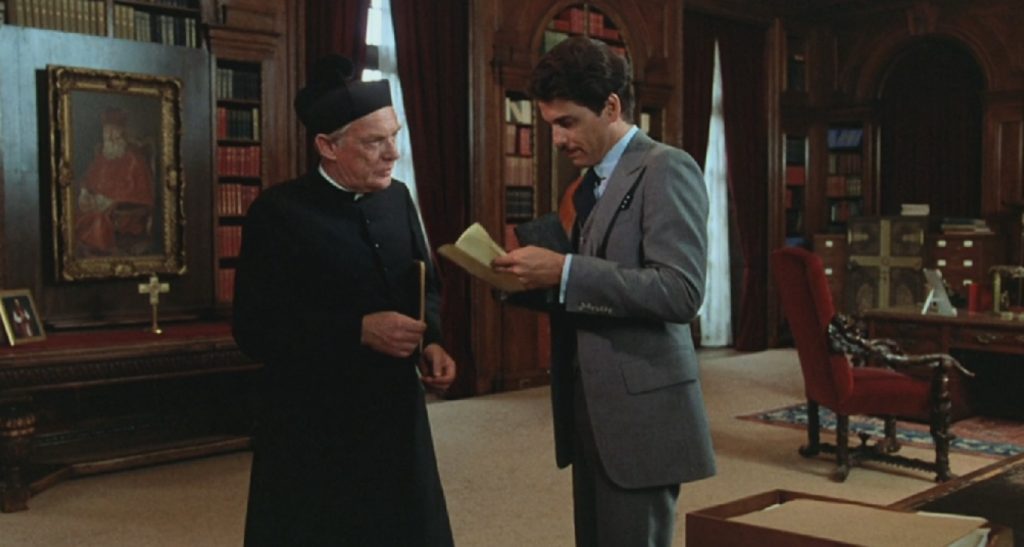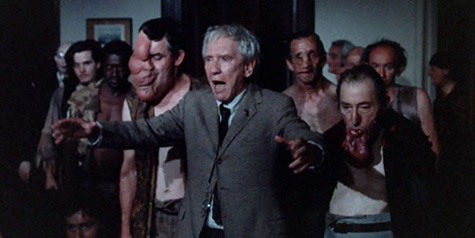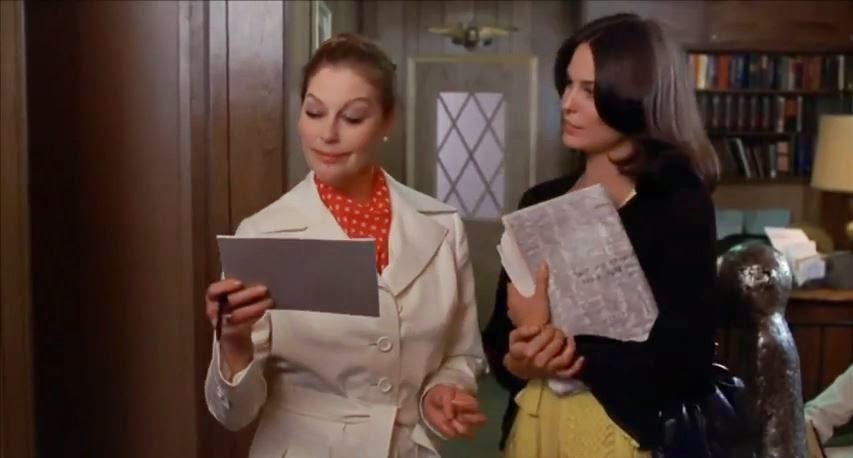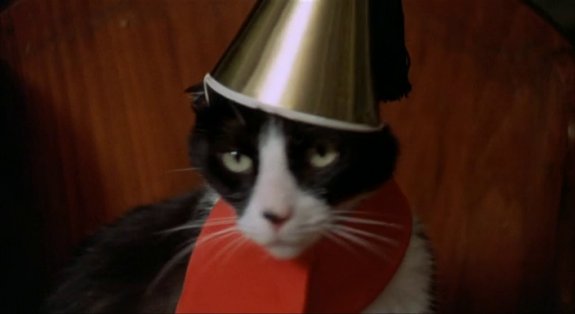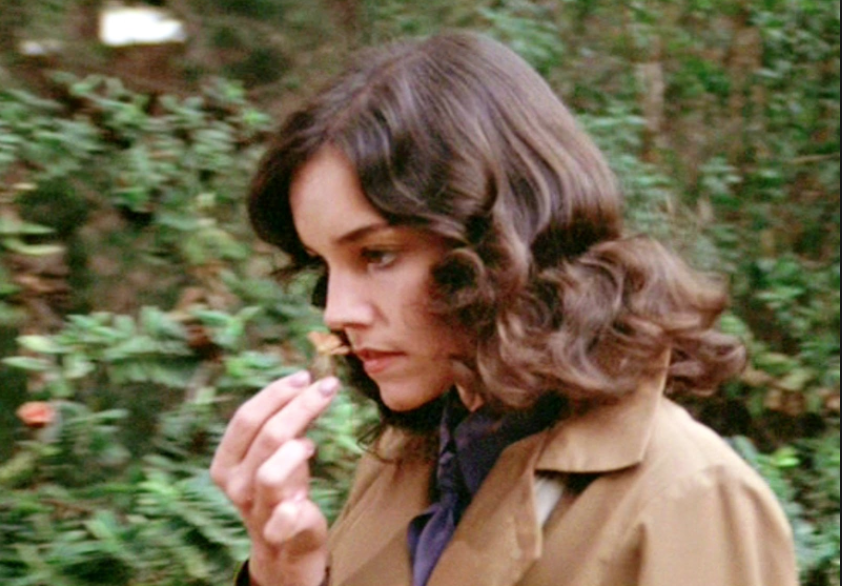
This January, in support of the Toronto Rape Crisis Centre / Multicultural Women Against Rape, friends and family have raised over $1,500 (which, when matched by my employer, totals $3,000). As a result, I now have to watch and write about thirty-one horror movies: one each night. Any donors who contributed over $30 were given the option to choose one of the horror movies I must subject myself to. After each viewing, I will write some things about said movies on this website. Be forewarned that all such write-ups will contain spoilers, and many of them will refer to unpleasant and potentially triggering situations. What better to follow up on last night’s movie than the (first) remake of Invasion of the Body Snatchers (1978), directed by Philip Kaufman (The Right Stuff, The Unbearable Lightness of Being), and suggested by friend, president of book distributor Ampersand, and former college instructor of mine Saffron Beckwith. I also picked up a DVD of this version Invasion of the Body Snatchers from Queen Video. Lets compare and contrast, shall we?
What happens:
The late 1970s version of Invasion of the Body Snatchers is nearly identical to the original (and, I imagine, the book by Jack Finney upon which it’s based), but differs in a few notable ways. For one, our story does not take place in the fictional small town of Santa Mira, but the swingin’ 70s metropolis of San Francisco! And instead of opening with a frame in which our hero recounts hist story, this film opens on an alien wasteland, where we see the seed pods rise from the planet, travel through space, and rain down on the Golden City, infecting the plant life. Department of Health employee Elizabeth Driscoll (Brooke Adams) spots an unusual flowering plant and decides to take it home.
She returns to find her dentist boyfriend, Geoffrey (Canadian treasure Art Hindle) busy watching basketball with headphones on. She shows him the special plant and has a difficult time identifying it in her plant reference books. Across town, tough-as-nails health inspector (and Elizabeth’s co-worker), Matthew Bennell (other Canadian treasure Donald Sutherland) is putting the screws to a French restaurant after he finds a rat turd in their soup stock. (They assert it’s actually a caper.) Not everyone appreciates Matthew’s work ethic, and he finds his car’s windshield broken by an inexpensive bottle of French wine. Fittingly, we view much of the film’s later scenes through Matthew’s splintered glass.

When he returns home, Matthew calls Elizabeth and informs her he needs her to come into work early the next day. Reluctantly, she agrees and falls asleep with the newfound plant set at Geoffrey’s bedside. Atypically, her sports-loving boyfriend is up and dressed early, sweeping up debris on the bedroom floor. He doesn’t say much, just takes the refuse directly to the back of the garbage truck, and heads off to work. Elizabeth, however, confused by Geoffrey’s behaviour, arrives within the marbled walls of the Department of Health later than expected. Once there, she shares with Matthew how strange Geoffrey has been acting: “He was just weird.” After work, he becomes stranger, passing up Warriors tickets in favour of a mysterious meeting. When Elizabeth questions him, he puts up a wall: “I don’t need to justify my every action to you.”
Left alone for the evening, Elizabeth visits co-worker Matthew at his apartment, where he’s whipping up a delicious stir fry and flirting up a storm. She tries to explain how Geoffrey has changed: the feelings, the emotions are different. But he’s clearly the same person. Elizabeth starts to wonder if she’s experiencing psychotic delusions. Matthew offers to introduce her to his friend, celebrity psychiatrist, Dr. David Kibner – not because he thinks she’s mentally ill, but because Kibner could help eliminate possibilities, such as if Geoffrey has “become gay” or has contracted a “social disease.”
The next morning, Matthew drops off some stained clothing at his Chinese dry cleaners, and the co-owner tells him his wife is not his wife. Elizabeth later surprises him when he’s working late at the office to dish more info on Geoffrey’s strange behaviour. That day, she followed him to work, and witnessed him meet with people she’d never seen before, passing around things swaddled in blankets. Overnight, everything has become frightening and conspiratorial. They decide to meet with Dr. Kibner right away – that evening he’s launching a new book – and drive to see him. Along the way, they nearly run over a man ranting in the street (Kevin McCarthy, star of the original film, in a clever cameo). The seemingly disturbed man is run down by a car moments later and a gathered crowd seems content to just watch him die in the street.
At the book launch, they meet their friend, Jack Bellicec, who seems to be a failed writer of sorts, and doesn’t take much stock in Kibner’s acclaimed ideas. That’s when we meet Dr. Kibner (Leonard Nimoy), busy on-stage consulting a woman, Katherine (Leila Golden) who loudly proclaims her husband, Ted (Tom Luddy) is an impostor. Elizabeth wants to intervene with valuable information – namely that she’s felt the same way about her husband and, further, that she’s seen this woman’s husband meeting with her own. But Kibner refuses to let Elizabeth talk, and instead reconciles husband and wife with his quiet, soothing words.
Kibner takes Elizabeth and Matthew outside to discuss Elizabeth’s personal crisis. He doesn’t believe that Geoffrey is an impostor any more than that woman’s husband was. Instead, he sees this rash of people claiming their loved ones as impostors as a symptom of the modern world, where people enter and leave relationships too quickly. He suggests that Elizabeth is seeing Geoffrey as an impostor because it’s an easy way to excuse herself from their relationship. Then, confusingly, as Jack approaches them, Kibner throws him up against the wall, to “shock her.” (These Invasion movies are, invariably, packed with suspect psychiatrists.)
Jack returns to his place of business, Bellicec Baths, a spa and mud bath that doesn’t seem overly hygienic. (They definitely reuse the mud at Bellicec Baths.) His wife, Nancy Bellicec (Veronica Cartwright), a crunchy granola type, is hard at work assisting customers, but Jack, aggravated by his encounter with Dr. Kibner, treats himself to a steam. We learn that Mr. Gianni, an intense reader and regular spa customer, recently gifted Nancy a plant (!), which explains why why she later finds a half-formed slimy clone on one of the massage tables and screams blue murder.
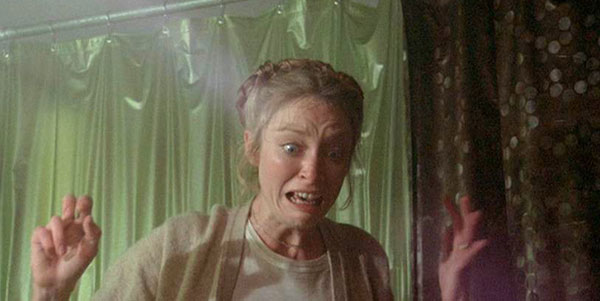
Matthew has accompanied Elizabeth back to Geoffrey’s apartment, but the dentist is nowhere to be seen (though we viewers see him lurking in the shadows). Shortly after Matthew has brought Elizabeth home safe, he gets a call from the Bellicecs to do a little unofficial health inspection. He arrives and sees the smooth, vague body with his very own eyes, declaring it not unlike some sort of adult fetus. As you’d expect, they soon determine this body is the same height and build as Jack (though Goldblum’s Jack is significantly taller than King Donovan’s). Realizing what impossibly seems to be occurring, Matthew calls Geoffrey’s apartment to warn Elizabeth, but Elizabeth is already being drained by and covered with plant tendrils. Geoffrey takes the telephone from her and leaves it off the hook. Sensing skullduggery, Matthew leaves immediately.
This leaves Jack and Nancy with the half-formed clone. At some point, Jack injured himself and got himself a nosebleed. So when Jack lays down to rest, the clone opens his eyes the very moment the real Jack’s eyes close. Also, his nose begins to bleed. Oh, and tendrils start to creep out from his body. Nancy sees this alarming phenomenon and wakes her husband, and then Dr. Kibner arrives to surprise them both. Back at Geoffrey’s house, Matthew decides to break in through the basement window. Geoffrey has headphones on to watch the basketball game, so doesn’t notice at Matthew creeps upstairs to see an Elizabeth clone, surrounded by lush plants, and the real Elizabeth, unconscious in her bed. He tries in vain to wake her, and when this fails, he carries her out the way he came.
Back at the Bellicec Baths, Kibner returns to his friends in the lobby to tell them there’s nothing remotely like a body in there. Jack and Nancy can’t believe this and tear the spa apart looking for the clone. Kibner thinks one of Jack’s friends must have played a practical joke on him. “I don’t have any friends,” Jack mumbles. That’s when Matthew returns with Elizabeth and asks Nancy to take her back to his apartment. He calls the police from the spa and reports a body at Geoffrey’s, but when the police, Kibner, and Geoffrey arrive, what was a clone is now a few ceramic pots surrounded by houseplants. Elizabeth, however, is missing, and – given the circumstances, it looks like Matthew kind of kidnapped her. However, Kibner is able to smooth things over with the police – the detective’s wife is a big fan of his books – and Geoffrey decides not to press charges.
Our protagonists go over the situation at Matthew’s apartment, and Dr. Kibner can’t believe what his friends are saying – they seem to be buying entirely into fantastical notions. Most fantastical of all: that a flower – the flower Elizabeth found and the one that a client brought to the spa – is somehow responsible. A flower, perhaps, from outer space! (“Why do we expect metal ships?” Nancy asks.) However, Kibner agrees to do a favour for Matthew and set up a phone call with the mayor, one of his patients. However, Matthew gets the runaround from every government official he contacts. No one will listen to his plea. (However, we viewers expected that, for we saw Kibner later enter a car with noted pod people Geoffrey and Ted. He’s already one of them.)
Elizabeth, while Matthew is attempting to elicit help from the authorities, takes the flower to her colleague at the Department of Health to be be analyzed. (Nothing ever comes of that.) Over the course of day, people who had previously believed their loved ones were impostors – the dry cleaner, Katherine from the book launch – assure Matthew and Elizabeth they were mistaken. Our heroes hole up in Matthew’s hilltop apartment, where Kibner advises a good night’s rest before departing.
Matthew Bennell visits his apartment’s rooftop garden, but soon begins to doze in a lawn chair. As he does, tendrils emerge from the garden to ensnare him. Then a giant flower (not noticed by Matthew earlier) basically begins to give birth (it’s very yonal), ejecting a plant fetus that slowly takes shape as a Donald Sutherland duplicate. Also on the rooftop, clones of Jack, Nancy, and Elizabeth begin to take shape. Luckily, Nancy ascends to the roof and wakes Matthew up with a scream when she sees the slowly forming doubles. Matthew and Nancy race downstairs to call the police, who somehow already know who’s calling. Everybody’s in on it! Then the power’s cut and the streets outside are barricaded.
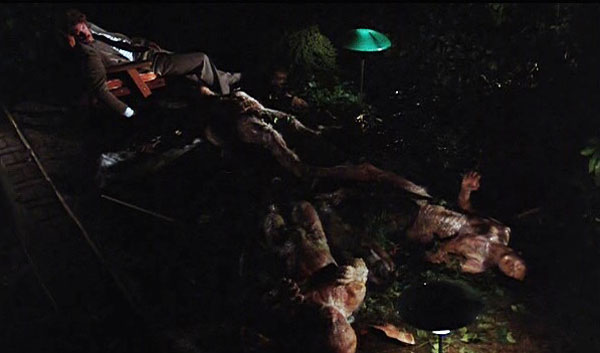
Our survivors go to the roof to leave via the fire escape. Before leaving, Matthew picks up a shovel and attempts to work up the courage to kill the Elizabeth clone. While he fails, he succeeds in smashing in the face of his own clone in a horrible, gory mess. Once the four hit the street level, they are chased through the night by nearly everyone in the city. The pod people begin emitting a horrible screech as chase them down a long flight of stairs (way easier a trip than up the staircase, as in the original!). They overcome numerous obstacles but are completely stymied by a chain link fence that’s about the height of Jeff Goldblum. When a police helicopter arrives, Jack and Nancy race in the other direction to draw it away, leaving Matthew and Elizabeth on their own.
Elizabeth and Matthew speed-walk into a seedier area of the city (which seems like it hasn’t been infiltrated by pod people). They find a cab and instruct the driver to take them to the airport, but become increasingly paranoid with every question the cabbie asks. The airport is crawling with police, and when the cops stop the taxi, Elizabeth and Matthew escape out the back. They make it back to the Department of the Health (must be near the airport), where their busker friend and his dog companion are unconscious beside a large flower. (Matthew gives the flower a swift kick and it oozes blood.)
A police officer follows them into their offices, and Elizabeth and Matthew have to hide in a darkened closet. While in hiding, Matthew and Elizabeth kiss, with Matthew looking for the world like he’s trying to loosen a screw with his lips (further bolstering my theory that Donald Sutherland can’t kiss – a theory first established after watching Don’t Look Now). After the cop leaves, they take a look out the window and spot trucks distributing massive seed pods to dozens and dozens of people. Elizabeth begins to lose hope. The pod people seemingly control the city, and she’s too exhausted to go on. Luckily, they find a solution in their office: speed. “How many does it say to take?” Matthew asks. “One,” Elizabeth answers. “Take five.”
Jack Bellicec arrives at the office, but he’s also brought Kibner, Geoffrey, and a few others with him. Jack has been assimilated. They restrain Matthew and Elizabeth while Dr. Kibner injects them both with a sedative to assist them in falling asleep, all while making a speech similar to the one Kaufman makes in the original film. Being a pod person frees them from troubles, from anxiety, from feeling. Matthew argues that becoming a pod person also means you all think the same – Jack and Kibner always fought before, and now they agree on everything. Elizabeth confesses to Matthew, “I love you,” but Matthew leaves that admission just hanging there.
The pod people drag Matthew and Elizabeth in front of two fresh pods, but Elizabeth breaks a bottle over Kibner’s head and Matthew chokes Jack out (and apparently stabs him in the back of the head with a dart). Seeing the elevator guarded, they try to escape via the stairs. They encounter Nancy in the stairwell, but she seems to be her old self. (Not a pod person!) She provides our heroes with some helpful tips – she’s discovered you can fool the pod people by not showing emotion. The three leave the office and line up to collect pods as blankly as they can.
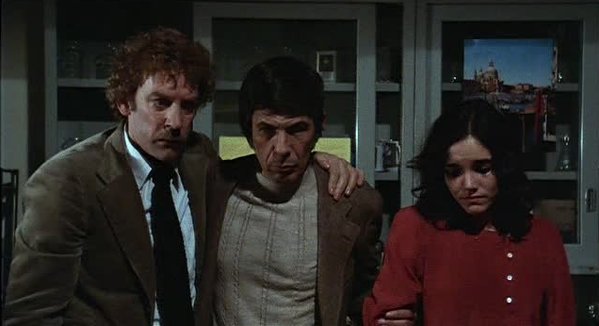
However, while waiting in line, they encounter a grotesque sight: the busker’s dog has fused with the human busker’s face. (Why this happens is never explained.) The frightful sight causes Elizabeth to shriek, and they’re found out as humans! Found out, Matthew slaps an old lady and they flee, leaping unseen onto the back of a transport truck.
The truck brings them to an enormous factory where the pod people’s operations are centred. Unfortunately, Elizabeth rolls her ankle, which slows them down a bit. After the injury, Matthew then admits he loves her too. (Sure. When no one else is around, Matthew.) While hiding in some tall grasses outside the factory, they hear bagpipes playing “Amazing Grace.” Realizing only a human being could be idiosyncratic enough to enjoy the sound of bagpipes, Matthew tells Elizabeth to stay put while he investigates. The music is coming from a radio upon a large cargo ship, which is when Matthew remembers he lives in a port city! They could escape on a ship! Unfortunately, the ship in question is being loaded with massive seed pods.
Matthew returns to Elizabeth to see she’s fallen asleep in the reeds, and her body is covered in vines. He tries to shake her awake, promising her that the ships will take them away. But Elizabeth rots and turns to plant goo (answering the question of what happens to the original humans once cloned). The clone Elizabeth pops up in the reeds, stark naked, and beckons him to join her in sleep. Matthew runs and Elizabeth cries her banshee wail, pointing out the interloping human being.
Our surviving human hero returns to the pod compound, where he encounters a massive greenhouse with rows and rows of pods being incubated by overhead lights. Matthew scurries up to the rafters, a la Soylent Green, and grabs a fire axe. Alarms immediately sound and a nude Elizabeth storms in, pointing toward Matthew above and emitting her piercing wail. But it’s too late. Matthew starts attacking the light rigging with ferocity, bringing the lights down on the plants in a series of fiery explosion.
Matthew slides out of the compound via the roof, with the pod people hot on his heels and the factory exploding around him. The pod people chase him down the street and Matthew finds refuge under a boardwalk. One pursuer peers down into the boardwalk below and shines a flashlight that provides a nice filmic transition to the next morning.
The next day, we see Matthew sauntering down the street, walking among the unsuspecting pod people doing their old jobs, if somewhat more joylessly than usual. Matthew, as before, cuts clippings from the paper. Business as usual. At lunch, he walks over to City Hall when he’s stopped by Nancy. (Remember her? She’s still human.) Hearing Nancy’s voice, Matthew turns, raises his pointer finger at her, and shrieks the pod person shriek. (OMG!)
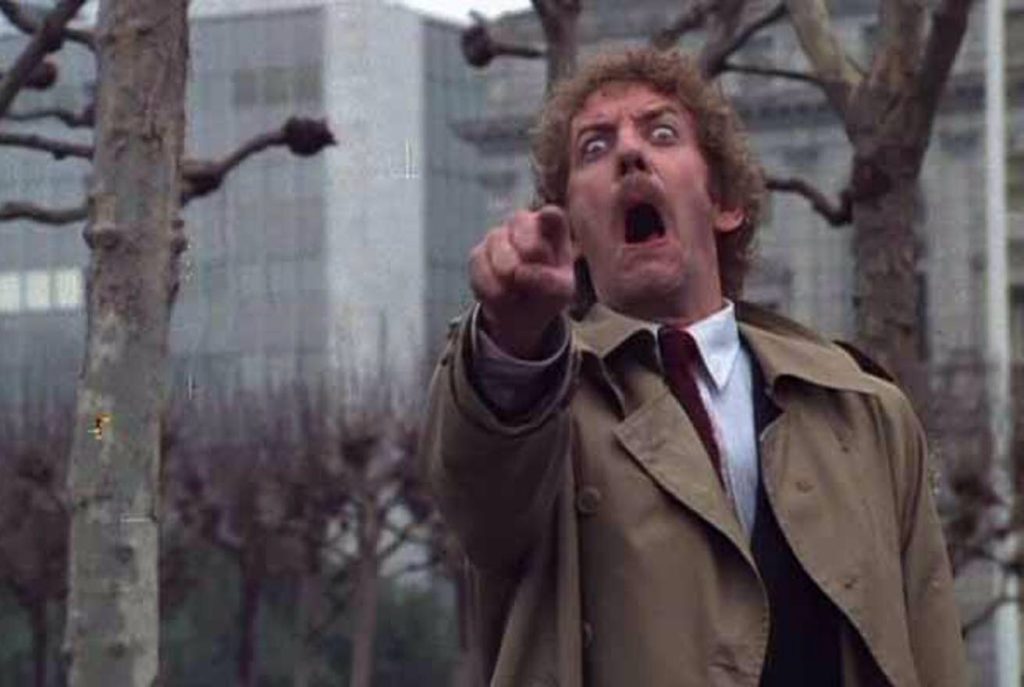
Takeaway points:
- If the original Invasion of the Body Snatchers was either an allegory for Communism or allegory for McCarthyism, what does this film, made in 1978 mean? The same premise is in place: individualism crushed by a collective will, a creeping inhumanity infecting the populace. But there are clues that this inhumanity arises not from any sort of political dogma, but (strangely) the social phenomenon of self-interest. This is the era of the Me Decade. This film is set in a city, where people are naturally more distant (rather than the quaint and friendly small town of Santa Mira), precisely to emphasize this reading. Kibner notes people these days are more self-interested, less willing to work out a difficult relationship (something a male psychologist would say). Even when the street ranter is run over in the street, no one makes a move to help; they just watch him die. And this is before most of them are pod people. It’s not a stretch to say that Kaufman uses Invasion as a warning that people’s individualism not turn to solipsistic self-interest.
- Interestingly, if you read the man ranting in the street as Dr. Miles Bennell (from the original film), this Invasion becomes not a remake, but a sequel of sorts. The framing device in the first movie could be read as a dream sequence. The invasion has spread from Santa Mira to the major city of San Francisco. And instead of saving humanity, Miles dies in the street. (Grim!)
- Though the remake lacks the framing device of the original, the cosmic introduction (revealing definitively the extraterrestrial origin of our seed pods) does the job of removing any ambiguity. We know it’s an invasion; we saw the pods. There’s never a question over whether this is a mass delusion. It does, however, also have a way more cynical end. Perhaps post-Vietnam and Watergate, Americans couldn’t believe in the false hope at the end of the original. There’s no chance for Nancy. All hope dies at the film’s conclusion.
- Though there have been two other remakes of the central Invasion of the Body Snatchers story, it would be interesting to see a non-white and non-American (or specifically recent immigrant) director tackle the story. The films are about assimilation, but it’s invariably the white American majority who are fearful of this assimilation. What would a similar film look like from the perspective of someone who has had to struggle with his or her own assimilation into white America? That would likely be a very different and very interesting Invasion.
- Can we admit that Nancy Bellicec (Veronica Cartwright) is the real hero of Invasion of the Body Snatchers? She first alerts people to the duplicates, she survives the longest, she’s the first to champion the idea of the “space flower,” she draws the police away from Matthew and Elizabeth, and she comes up with the idea to act blankly to confuse the pod people. Without Nancy, our other protagonists would have died forty minutes into this film.
Truly terrifying or truly terrible?: Invasion of the Body Snatchers is a solid remake – mostly faithful to the original with an added level of Watergate-era paranoia, and a couple unsettling scenes of gore. And the sounds the pod people make are enough to give nightmares on their own. There are scares, for sure.
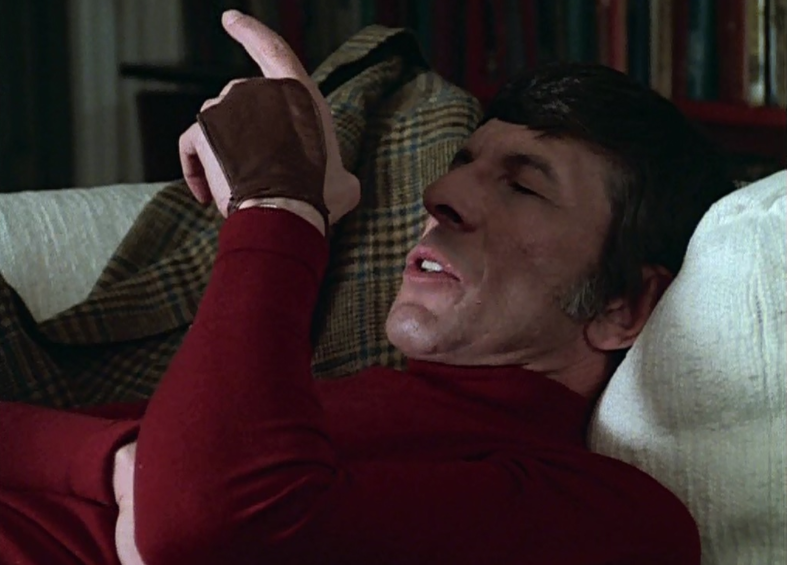
Best outfit: There’s a lot of great 70s-era fashion on parade, but you have to hand it to Dr. Kibner, king of the useless accessory, for his leather half-glove that he wears for no apparent reason.
Best line: “What’s a big conspiracy?” Matthew asks Jack. “Everything,” he responds.
Best kill: Matthew Bennell smashing in his own face with a shovel haunts my dreams. After seeing it, you won’t be able to see Donald Sutherland’s face without imagining it caved in by a garden implement and gushing blood.
Unexpected cameo: The inclusion of the original film’s star, Kevin McCarthy, playing the exact same role he did at the end of the first movie, is a stroke of genius. Additionally, the original film’s director, Don Siegel has a cameo as the taxi driver who takes our heroes to the airport. Weirder still, Robert Duvall has an inexplicable cameo as a priest playing on a child’s swing in one brief scene.
Unexpected lesson learned: Most health inspectors are, at heart, failed chefs themselves.
Most suitable band name derived from the movie: Worlds in Collision (the title of the book Nancy’s literate client recommends).
Next up: Mr. Vampire (1985)
